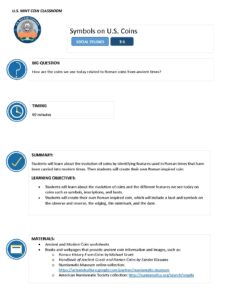Summary
Objectives
- Students will learn about the evolution of coins and the different features we see today on coins such as symbols, inscriptions, and busts.
- Students will create their own Roman-inspired coin, which will include a bust and symbols on the obverse and reverse, the edging, the mintmark, and the date.
Subject Area
- Coins & Mint
Grades
- 3rd
- 4th
Class Time
- Total Time: 46-90 Minutes minutes
Materials
- Ancient and Modern Coin worksheets
- Books and webpages that provide ancient coin information and images, such as:
- Roman History From Coins by Michael Grant
- Handbook of Ancient Greek and Roman Coins by Zander Klawans
- Numismatic Museum online collection: https://artsandculture.google.com/partner/numismatic-museum
- American Numismatic Society collection: http://numismatics.org/search/results
Lesson Steps
1. Introduce the activity by displaying a penny (or project a large image of a penny) for the whole class to see. Ask your students what it is, and what we use it for. Explain to your students that if they look closer at coins, they will see that each one is a piece of artwork that tells us about a country's culture.
2. Ask students to describe what they see on the penny. Some answers might include a face, a date, words, or the edge/rim.
3. Tell students that they are going to look at how the design of the penny came to be. Let students know that the first coins were used thousands of years ago and that we are going to take a look at ancient coins to see if they are the same or different than the coins we use today.
Compare modern and ancient coins and symbols using worksheet (20 minutes)4. Distribute the Ancient and Modern Coin worksheets with images of ancient and currently circulating U.S. coins.
-
- First, review the parts of a coin with your students using the graphic and definitions of key terms on the first page of the worksheet.
- Then ask students to review the images of ancient Roman coins.
- Ask students to write down at least 3 observations about the Roman coins and how they are both similar and different to modern coins.
- As a class, discuss the similarities and differences between the ancient coins and the circulating coins. Some symbols and similarities you can share:
-
- Leader's bust or portrait: Roman coin features emperors such as Augustus and U.S. coins feature presidents.
- Oak branch: Symbolize strength and independence, featured on both the dime and Roman coin.
- Wreath: Symbolizes victory, used in both Roman and modern coins.
- Olive branch: Symbolize peace and is used in both Roman and modern coins.
- Size and Shape: Coins are roughly the same size and made from similar metals today as they were in Roman times.
- Text: All of the coin examples feature writing or inscriptions of some kind.
- Modern coins include a year and a mint mark so you can tell when and where the coin was made.
- Eagle: The Bald Eagle is the national bird. In Roman times, the eagle was a symbol representing power and was an emblem for the army.
5. Tell your students that they will be creating their own coin to represent an aspect of our culture that they feel is important. Tell students they can choose to design their coin to look older like a Roman coin, or they can choose to make their coin appear more modern. Discuss possible coin topics as a class.
6. Have your student create sketches of the front (obverse) and back (reverse) of the proposed coin. The coin sketches should include a portrait and date on the front and a legend, symbol, and denominational amount on the back.
Differentiated Learning Options
- When comparing ancient coins to modern coins with your class, you could also have your students examine modern foreign coins to see if they too use symbols to represent their culture or their history.
- In groups, ask students to research one Roman coin and present to the class who is on the coin, why they were important to the Roman Empire, and what the other symbols on the coin represent.
- If teaching virtually, ask students to use the Making Change game to create a coin instead of drawing on paper.
- Display/project an image of a modern U.S. coin using the Mint website.

